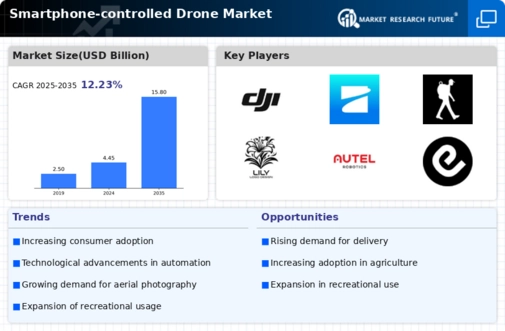Top Industry Leaders in the Smartphone Controlled Drone Market

Key players :
3DR (US)
CONTIXO (US)
DBPOWER (China)
DJI (China)
Draganfly Innovations Inc. (Canada)
GoPro Inc. (US)
Guangdong Cheerson Hobby Technology Company Limited (China)
Kidcia (China)
Strategies Adopted
Parrot Drones SAS (France)The smartphone-controlled drone market has witnessed a dynamic and competitive landscape, driven by technological advancements and the growing demand for consumer drones. Several key players dominate this space, each employing unique strategies to gain a competitive edge. DJI, a Chinese technology giant, has consistently maintained its leadership position through a combination of innovation and a diverse product portfolio. Their drones, such as the Mavic and Phantom series, have set industry standards, offering advanced features like obstacle avoidance and high-quality cameras.
Competing against DJI is Parrot, a French drone manufacturer, known for its focus on consumer-friendly designs. Parrot has strategically targeted the mid-range market, offering drones like the Anafi series, which emphasizes compactness and ease of use. This positioning has allowed Parrot to carve a niche for itself, appealing to consumers seeking a balance between affordability and advanced features.
In the pursuit of market dominance, companies are increasingly incorporating cutting-edge technologies. Skydio, an American drone manufacturer, has gained attention for its autonomous drones equipped with artificial intelligence (AI) for obstacle avoidance and navigation. This unique selling proposition positions Skydio as a frontrunner in the development of autonomous drone technology, catering to consumers and professionals alike.
Emerging Companies
As the market evolves, the entry of new and emerging companies adds further complexity to the competitive landscape. Autel Robotics, another American player, has made strides with its EVO series, competing in terms of performance and camera capabilities. Yuneec, a Chinese-German joint venture, has also made noteworthy contributions with its Typhoon and Mantis series, targeting both consumer and professional markets.
Factors for market share analysis in the smartphone-controlled drone market include product features, pricing, brand reputation, and customer service. DJI's strong market position can be attributed to a combination of premium features and competitive pricing. The company's commitment to continuous innovation and a robust ecosystem, including smartphone apps for control and monitoring, has contributed to its sustained dominance.
Parrot, on the other hand, has gained market share by appealing to a specific segment of consumers seeking user-friendly drones at affordable prices. With a focus on design and ease of use, Parrot has successfully positioned itself as a viable alternative to DJI for those looking for less complex yet feature-rich drone options.
In terms of technology, companies like Skydio and Autel Robotics are gaining traction by offering advanced features such as autonomous flight capabilities and obstacle avoidance. These technological differentiators play a crucial role in attracting consumers who prioritize cutting-edge capabilities in their drone purchases.
The competitive scenario is also influenced by industry news and trends. Ongoing advancements in battery technology, improvements in camera capabilities, and the integration of AI are shaping the landscape. News about regulatory developments, such as drone usage guidelines and airspace regulations, can impact market dynamics as companies adapt to compliance requirements.
Investment trends in the smartphone-controlled drone market reflect the industry's growth potential and the confidence of investors in various companies. DJI's success has attracted significant investments, allowing the company to continue its research and development efforts, expand its product line, and strengthen its market presence. Skydio's recent funding rounds highlight investor interest in companies focusing on autonomous drone technology.
New players entering the market, such as Autel Robotics and Yuneec, have also secured investments to fuel their expansion and product development initiatives. This influx of capital indicates a positive outlook for the smartphone-controlled drone market, with investors recognizing the potential for further innovation and market growth.
Recent News
The smartphone-controlled drone market is buzzing with activity, and key companies are making headlines with exciting developments. Here's a glimpse into the latest news:
DJI:
The industry leader, DJI, recently unveiled its DJI Mavic 3 Cine drone, boasting a Hasselblad camera with a 4/3 CMOS sensor and an adjustable aperture for professional-grade aerial photography and videography.
They also announced a partnership with Leica Geosystems to develop enterprise-focused drones for surveying and mapping applications.
Autel Robotics:
Autel Robotics is making waves with its Evo II series, offering high-performance drones with advanced obstacle avoidance and long flight times. Their Evo Nano series caters to the beginner market with compact and affordable drones.
Autel recently raised $80 million in funding, showcasing investor confidence in its growth potential.
Skydio:
Known for its autonomous flight technology, Skydio launched its X2 drone, featuring advanced subject tracking and automatic collision avoidance for effortless piloting.
They're also partnering with emergency services to explore the use of drones for search and rescue operations.
PowerEye:
PowerEye's PowerEye Weather drone is designed for extreme weather conditions, making it valuable for storm chasing, disaster response, and infrastructure inspection.
They recently secured a contract with the U.S. Air Force for weather research, highlighting the drone's potential for government applications.
Beyond Key Companies:
New regulations and airspace restrictions are being implemented worldwide, shaping the landscape for drone operations. Companies are adapting by developing features like geofencing and compliance tools.
The integration of AI and machine learning is enhancing drone capabilities, paving the way for autonomous missions and intelligent flight modes.










